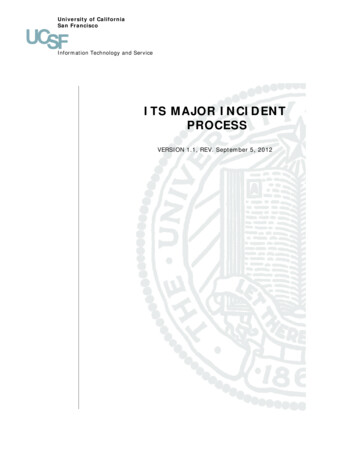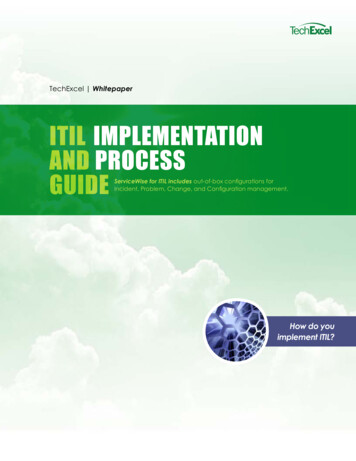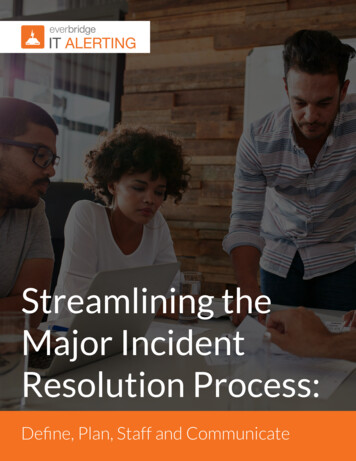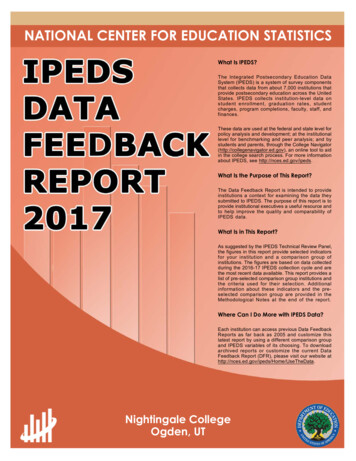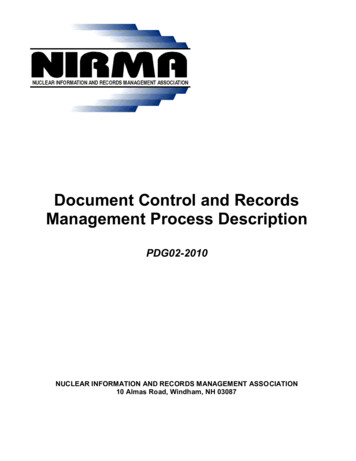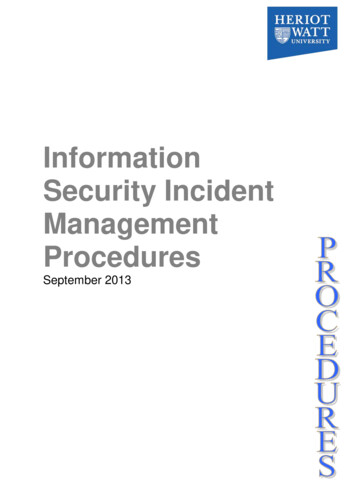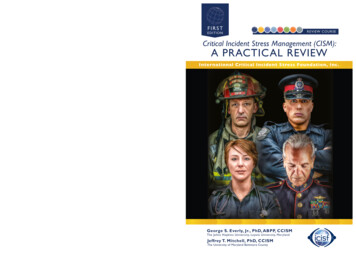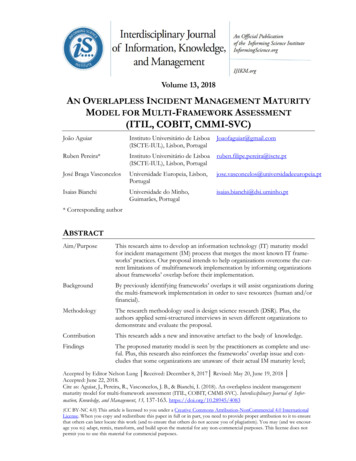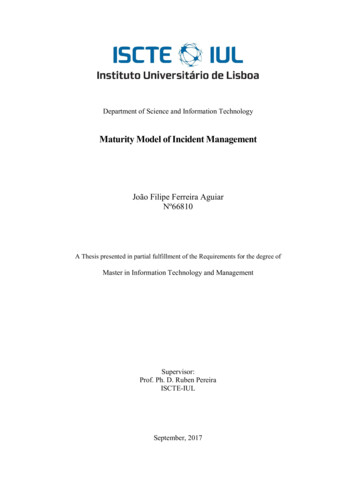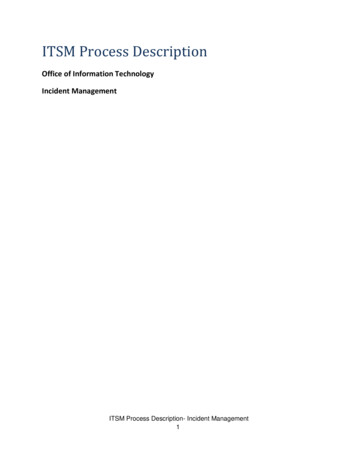
Transcription
ITSM Process DescriptionOffice of Information TechnologyIncident ManagementITSM Process Description- Incident Management1
Table of ContentsTable of Contents1. Introduction2. Incident Management Goals, Objectives, CSFs and KPIs3. Incident Management Scope3.1 General Process Scope3.2 Deployment Scope4. Benefits4.1 Benefits To The IT Service Providers4.2 Benefits To The Users5. Key Terms & Definitions6. Roles & Responsibilities6.1 Incident Management Process Owner6.2 Incident Management Process Manager6.3 Tier 1 Technician6.4 Tier 2 Incident Coordinator6.5 Tier 2 Incident Technician6.6 User7.0 Incident Management High Level Process Flow7.1 Incident Management High Level Process Descriptions8.0 Incident Management Tier 1 Process Flow8.1 Incident Management Tier 1 Process Activity Descriptions8.2 Incident Management Tier 1 Process RACI Matrix9.0 Incident Management Tier 2 Process Flow9.1 Incident Management Tier 2 Process Activity Descriptions9.2 Incident Management Tier 2 Process RACI Matrix10.0 Incident Management Verify Document & Close Process Flow10.1 Incident Management Verify, Document & Close (VD&C) Process ActivityDescriptions10.2 Incident Management VD&C Process RACI MatrixITSM Process Description- Incident Management2
1. IntroductionThe purpose of this document is to provide a general overview of the Office of Information Technology(OIT) Incident Management Process. It includes Incident Management goals, objectives, scope, benefits,key terms, roles, responsibilities, authority, process diagrams and associated activity descriptions.The content within this general overview is based on the best practices of the ITIL framework[1].2. Incident Management Goals, Objectives, CSFs and KPIsGoals, objectives and critical success factors (CSFs) define why Incident Management is important to theOffice of Information Technology’s overall vision for delivering and supporting effective and efficient ITservices. This section establishes the fundamental goals, objectives and CSFs that underpin the IncidentManagement process. The agreed and documented goals, objectives and CSFs provide a point ofreference to check implementation and operational decisions and activities.Incident Management is the process responsible for managing the lifecycle of all Incidents irrespectiveof their origination.The goals for the Incident Management process are to: Restore normal service operation as quickly as possible Minimize the adverse impact on business operations Ensure that agreed levels of service quality are maintainedTo achieve this, the objectives of OIT’s Incident Management process are to: Ensure that standardized methods and procedures are used for efficient and prompt response,analysis, documentation, ongoing management and reporting of Incidents Increase visibility and communication of Incidents to business and IT support staff Enhance business perception of IT through use of a professional approach in quickly resolvingand communicating incidents when they occur Align Incident management activities and priorities with those of the business Maintain user satisfaction with the quality of IT servicesCSFs identified for the process of Incident Management and associated Key Performance Indicators(KPIs) are:CSF #1 - OIT commitment to the Incident Management process; all departments using the same process.KPI 1.1 - Number of self service tickets via a customer portal verses tickets created by theService Desk.1.1.1 - Review metrics via ITSM tool on all incident requests recorded and escalated within OIT.KPI 1.2 - Management is known to review standardized reports produced by the IncidentManagement process.ITSM Process Description- Incident Management3
1.2.1 - ITSM tool, standardized/customized reports made available.KPI 1.3 - Number of incidents in ITSM tool per department.1.3.1 - Review metrics via ITSM tool on all incident requests recorded and escalated within OIT.KPI 1.4 - Management is known to be a user of the Incident Management process.1.4.1 - Review metrics via ITSM tool on all incident requests recorded and escalated within OIT.CSF #2 - Consistent, positive experience for all customersKPI 2.1 - Improved assignment, response and closure time.2.1.1 Review metrics via ITSM tool on all incident requests recorded and escalated within OITspecifically focusing on MTTR and customer satisfaction surveys.KPI 2.2 - Customer use of self service portal increases.2.2.1 Review metrics via ITSM tool on all incident requests recorded via self service portal.KPI 2.3 - Amount of journal entries consistent with SLA.2.3.1 Review metrics via ITSM tool for services with SLA specifically focusing on the quantity andquality of updates in incident requests.KPI 2.4 - number of incidents reopened.2.4.1 Review metrics via ITSM tool specifically looking at incidents that were reopened.CSF #3 Ability to track internal process performance and identify trends.KPI 3.1 - Process performance meets established standards in OIT Baseline SLA including:Assignment time, response time, resolution time, closure time.3.1.1 Review metrics via ITSM tool on all incident requests recorded and escalated within OIT;measuring MTTR and SLA requirements.KPI 3.2 - Number of re-assigned tickets between departments.3.2.1 Review metrics via ITSM tool on all incident requests recorded specifically looking atincidents that were reassigned.3. Incident Management ScopeScope refers to the boundaries or extent of influence to which Incident Management applies to theOffice of Information Technology. OIT’s Incident Management process consists of three sub-processestitled Tier 1, Tier 2 and Verify Document and Close (VD&C). The Tier 1 sub-process is initiated by anydepartment dealing directly with the user and able to resolve the incident without involving additionaldepartments. The Tier 2 sub-process is initiated when an Incident requires multiple departments toresolve an Incident. The VD&C sub-process provides a consistent experience for the user ensuring highlevels of customer service. Although it is an optional process, it is considered best practice fordepartments to adhere to. Boundaries for the extent of deployment within the Office of InformationTechnology are identified for users, service providers, geography, IT services and service componentsand environment.ITSM Process Description- Incident Management4
3.1 General Process ScopeAny event which disrupts, or which could disrupt, a service, including those: Reported directly by users Reported and/or logged by technical staff Detected by Event Management Reported and/or logged by SuppliersIncident Management encompasses all IT service providers, internal and third parties, reporting,recording or working on an Incident.All Incident Management activities should be implemented in full, operated as implemented, measuredand improved as necessary.3.2 Deployment ScopeIncident Management will be deployed and applicable to: Users covered by Service Level Agreements (SLAs) specifying service targets for resolution ofIncidents Service Providers adopting the Incident Management responsibilities outlined by Service LevelAgreements, Operating Level Agreements (OLAs), and Underpinning Contracts (UCs) Services to which Incident Management Resolution Targets agreed in Service Level Agreementsapply4. BenefitsThere are several qualitative and quantitative benefits that can be achieved, for both the IT serviceproviders and users, by implementing an effective and efficient Incident Management process. TheIncident Management project team has agreed that the following benefits are important to OIT and willbe assessed for input to continuous process improvement throughout the Incident Management processlifecycle: Capturing accurate data across OIT to analyze the level of resources applied to the IncidentManagement processInforming business units of the services OIT provides and the level of support and maintenancerequired for ongoing service levelsMinimize impacts to business functions by resolving incidents in a timely mannerProviding the best quality service for all usersITSM Process Description- Incident Management5
4.1 Benefits To The IT Service ProvidersIncident Management is highly visible to the business and it is easier to demonstrate its value than mostareas in Service Operation. A successful Incident Management process can be used to highlight otherareas that need attention: Improved ability to identify potential improvements to IT services Better prioritization of efforts Better use of resources, reduction in unplanned labor and associated costs More control over IT services Better alignment between departments More empowered IT staff Better control over vendors through Incident Management metrics4.2 Benefits To The Users Higher service availability due to reduced service downtimeReduction in unplanned labor and associated costsIT activity aligned to real-time business prioritiesIdentification of potential improvements to servicesIdentification of additional service or training requirements for the business or IT5. Key Terms & DefinitionsCommon terms and vocabulary may have disparate meanings for different organizations, disciplines orindividuals. It is essential early in a process implementation to agree on the common usage of terms. Itis recommended, where possible, not to diverge from Best Practice unless necessary as many otherusers and suppliers may be also using the same terms if they are following best practice processframeworks. This brings unity in the areas of communication to help enhance not only internal dialogbut also documentation, instructions, presentations, reports and interaction with other external bodies.The following key terms and definitions for the Incident Management process have been agreed by theIncident Management Project Team on behalf of the Office of Information Technology. These terms anddefinitions will be used throughout the process documentation, communications, training materials,tools and reports.The following are key terms and Best Practice definitions used in Incident Management. The IncidentManagement Project Team carefully read and agreed to each key term. Any changes and/or additionalkey terms should be listed, defined and agreed in this section.Note: Key terms and definitions must be verified and documented consistently across all ITIL processesimplemented in the organization.ITSM Process Description- Incident Management6
Change Management: The process for managing the addition, modification or removal of anything thatcould have an effect on IT Services resulting in minimal disruption to services and reduced risk. TheScope should include all IT Services, Configuration Items, Processes and Documentation.Escalation: An Activity that obtains additional resources when these are needed to meet service leveltargets or user expectations. Escalation may be needed within any IT service management process butis most commonly associated with Incident Management, Problem Management and the managementof user complaints. There are two types of escalation: functional escalation and hierarchical escalation.Event: Any change of state that has significance for the management of an IT service or otherconfiguration item. The term can also be used to mean an alert or notification created by any IT service,Configuration Item or a Monitoring tool. Events typically require IT Operations personnel to take actionsand often lead to Incidents being logged.Failure: Loss of ability to operate to specification, or to deliver the required output. The term Failuremay be used when referring to IT services, processes, activities and Configuration Items. A Failure oftencauses an Incident.Function: A team or group of people and the tools they use to carry out one of more Processes orActivities; for example, the Service Desk.Group: A number of people who are similar in some way. People who perform similar activities, eventhough they may work in different departments within OIT.Hierarchic Escalation: Informing or involving more senior levels of management to assist in anescalation.Impact: A measure of the effect of an Incident, Problem, or Change on Business Processes. Impact isoften based on how Service Levels will be affected. Impact and urgency are used to assign priority.Incident: An unplanned interruption to an IT service or reduction in the quality of an IT service. Failureof a Configuration Item that has not yet impacted service is also an Incident; for example, failure of onedisk from a mirror set.Incident Management: The process responsible for managing the lifecycle of all Incidents. The primarypurpose of Incident Management is to restore normal IT service operation as quickly as possible.Incident Record: A record containing the details of an Incident. Each Incident record documents thelifecycle of a single Incident.ITSM Process Description- Incident Management7
Incident Workflow: A way of predefining the steps that should be taken to handle a process for dealingwith a particular type of Incident in an agreed way.Incident Status Tracking: Tracking Incidents throughout their lifecycle for proper handling and statusreporting using indicators such as Open, In progress, Resolved and Closed.Normal Service Operation: The Service Operation defined within the Service Level Agreement (SLA)limits.Primary Technician: The technician who has responsibility for correcting the root cause issue and mustkeep users informed of progress. They are also responsible for coordinating child records.Priority: A category used to identify the relative importance of an Incident, Problem or Change. Priorityis based on impact and urgency and is used to identify required times for actions to be taken. Forexample, the SLA may state that Priority 2 Incidents must be resolved within 12 hours.Priority 1 Incident: The highest category of impact for an Incident which causes significant disruption tothe business. A separate procedure with shorter timescales and greater urgency should be used tohandle Major Incidents.Problem: The cause of one or more incidents.Quality Assurance (QA): Optional departmental process for ensuring a desired level of customer service.This process is defined by the departments that choose to review tickets prior to closure.RACI Matrix: A responsibility matrix showing who is Responsible, Accountable, Consulted and Informedfor each activity that is part of the Incident Management process.Role: A set of responsibilities, activities and authorities granted to a person or team. A role is defined ina process. One person or team may have multiple roles; for example, the roles of ConfigurationManager and Change Manager may be carried out by a single person.Service Desk: The Single Point of Contact between the Service Provider and the users. A typical ServiceDesk manages Incidents and Service Requests and also handles communication with the users.Severity: A measure of how long it will be until an Incident, Problem or Change has a significant impacton the business. For example, a high Impact Incident may have low urgency, if the impact will not affectthe business until the end of the financial year. Impact and urgency are used to assign Priority.ITSM Process Description- Incident Management8
Tier 1: Line staff who are the subject matter experts for assessing, planning and monitoring IncidentManagement for their functional organization and specific technology platform. They function ascontact people between the different departments for a specific process and may be responsible for thedesign of processes within their own departments.Tier 2: More in-depth technical support than tier 1. Tier 2 support personnel may be more experiencedor knowledgeable on a particular product or service. Additionally, Tier 2 may be able to provide onsitetroubleshooting and/or resolution. Specialized departments (i.e. Networks, Servers, Video) will provideTier 2 Support in their respective areas of expertise.User: Someone who uses the IT service on a day-to-day basis. Sometimes informally referred to as thecustomer.6. Roles & ResponsibilitiesA role refers to a set of connected behaviors or actions that are performed by a person, team or groupin a specific context. Process roles are defined by the set of responsibilities, activities and authoritiesgranted to the designated person, team or group.Some process roles may be full-time jobs while others are a portion of a job. One person or team mayhave multiple roles across multiple processes. Caution is given to combining roles for a person, team orgroup where separation of duties is required. For example, there is a conflict of interest when asoftware developer is also the independent tester for his or her own work.Regardless of the scope, role responsibilities should be agreed by management and included in yearlyobjectives. Once roles are assigned, the assignees must be empowered to execute the role activitiesand given the appropriate authority for holding other people accountable.All roles and designated person(s), team(s), or group(s) should be clearly communicated across theorganization. This should encourage or improve collaboration and cooperation for cross-functionalprocess activities.6.1 Incident Management Process OwnerProfileThe person fulfilling this role is responsible for ensuring that the process isbeing performed according to the agreed and documented process and ismeeting the aims of the process definition.There will be one, and only one, Incident Management Process Owner.ITSM Process Description- Incident Management9
Responsibilities Assist with and ultimately be responsible for the process design Define appropriate policies and standards to be employed throughoutthe process Define Key Performance Indicators (KPIs) to evaluate the effectivenessand efficiency of the process and design reporting specifications Ensure that quality reports are produced, distributed and utilized Review KPIs and take action required following the analysis Periodically audit the process to ensure compliance to policy andstandards Address any issues with the running of the process Review opportunities for process enhancements and for improvingthe efficiency and effectiveness of the process Ensure that all relevant staff have the required technical and businessunderstanding, knowledge and training in the process and are awareof their role in the process Ensure that the process, roles, responsibilities and documentation areregularly reviewed and audited Interface with the line management, ensuring that the processreceives the needed staff resources Provide input to the on-going Service Improvement Program Communicate process information or changes, as appropriate, toensure awareness Review integration issues between the various processes Integrate the process into the line organization Promote the Service Management vision to top-level/seniormanagement Function as a point of escalation when required Ensure that there is optimal fit between people, process andtechnology/tool Ensure that the Incident Management process is Fit for Purpose Attend top-level management meetings to assess and represent theIncident Management Requirements and provide ManagementInformationITSM Process Description- Incident Management10
6.2 Incident Management Process ManagerProfileTier 1 Technicians are the line staff who are the subject matter experts forassessing, planning and monitoring Incident Management for their functionalorganization and/or specific technology platform. They function as initialcontact between those reporting incidents and the IT organization.Technicians residing in departments where Tier 2 support is commonlyprovided may function as Tier 1 support. In this case the Technician is theinitial contact with those reporting incidents ands provides triage andresolution.Responsibilities Promote the Incident Management process Ensure the Incident Management process is used
KPI 1.4 - Management is known to be a user of the Incident Management process. 1.4.1 - Review metrics via ITSM tool on all incident requests recorded and escalated within OIT. CSF #2 - Consistent, positive experience for all customersFile Size: 782KB

